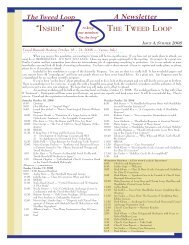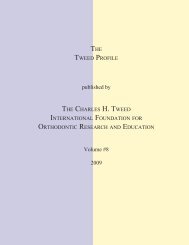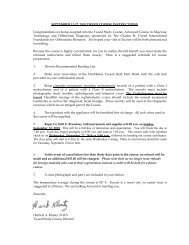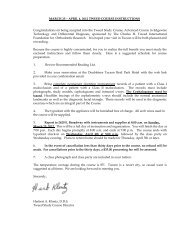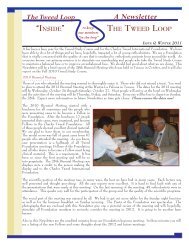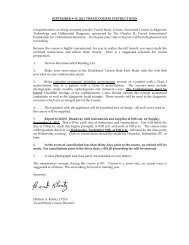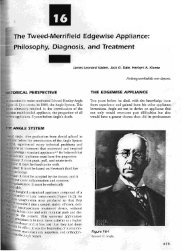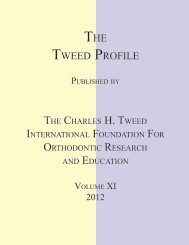the tweed profile - The Charles H. Tweed International Foundation
the tweed profile - The Charles H. Tweed International Foundation
the tweed profile - The Charles H. Tweed International Foundation
You also want an ePaper? Increase the reach of your titles
YUMPU automatically turns print PDFs into web optimized ePapers that Google loves.
<strong>the</strong> ra<strong>the</strong>r short anterior-posterior arch length should<br />
be noted. Indeed, <strong>the</strong> mandibular first molars are juxtaposed<br />
with <strong>the</strong> inferior border of <strong>the</strong> ramus. When<br />
Claire's key skeletal measurements were evaluated<br />
using <strong>the</strong> Cranio Facial Analysis developed by Dr. Jim<br />
Gramling, she had a skeletal difficulty of ninety six<br />
(Figure 6).<br />
<strong>The</strong> final section of <strong>the</strong> differential diagnosis is a<br />
thorough evaluation of <strong>the</strong> dentition (Figure 7). Claire<br />
presented with a Class II division 1 malocclusion with<br />
a full step class II molar relationship on her right side<br />
and an end-to-end relationship on <strong>the</strong> left. <strong>The</strong> total<br />
space analysis illuminated <strong>the</strong> areas of discrepancy.<br />
Her anterior denture has a 7.2 mm arch length deficiency,<br />
<strong>the</strong> mid arch has a 3.85mm deficiency and <strong>the</strong><br />
posterior has a 25.34 mm deficiency. Her total tooth<br />
size to arch length discrepancy was 36.39 mm (Figure<br />
8). When <strong>the</strong> space analysis difficulty was added to<br />
<strong>the</strong> cranio facial difficulty, <strong>the</strong> total of 136.72 placed<br />
Claire's malocclusion in <strong>the</strong> difficult range (Figure 9).<br />
Many factors needed to be considered when formulating<br />
Claire’s treatment plan. <strong>The</strong> short ramus, <strong>the</strong> severe<br />
posterior discrepancy, <strong>the</strong> high mandibular plane<br />
angle, and <strong>the</strong> very steep curve of Spee had to be considered.<br />
After combining <strong>the</strong> facial, skeletal and dental<br />
diagnostic factors, <strong>the</strong> decision to extract maxillary<br />
first premolars and mandibular second premolars and<br />
<strong>the</strong> use of <strong>Tweed</strong>-Merrifield directional forces offered<br />
<strong>the</strong> best alternative for Claire's treatment.<br />
Figure 5<br />
Figure 6<br />
Figure 7<br />
<strong>The</strong> steep curve of Spee dictated that care had to<br />
be taken when uprighting <strong>the</strong> mandibular first molars.<br />
Meticulous use of <strong>the</strong> "cherry loop" arch wire<br />
and careful read outs were evaluated monthly until<br />
a mandibular first molar measurement of +5 degrees<br />
was obtained prior to use of <strong>the</strong> "shoe-horn" loop to<br />
protract <strong>the</strong> molars.<br />
Claire's treatment was completed in twenty-two<br />
months. Facial changes can be seen in figures 10<br />
through 12. Of particular note is <strong>the</strong> much more symmetric<br />
and proportional relationship of her lips in repose.<br />
This type of response is typically seen when <strong>the</strong><br />
teeth are placed in an upright and harmonious position<br />
within <strong>the</strong> patient’s cranio-facial complex.<br />
Figure 8<br />
Figure 9<br />
56



